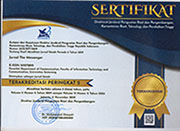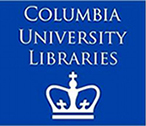National Private Television Network Competition based on Local Information Programs
Abstract
Introduction: In the ecological analysis of television media, researchers determine the category of supporting sources (niche breadth) of media and measure the level of competition (niche overlap) of media based on local content-based information programs on networked national private television in South Kalimantan.
Methods: This research employs a quantitative approach by collecting the data through observation of the program broadcasted by each television, then classifying into the instrument table and recording the results of the observations. The data is processed using the niche breadth and niche overlap formulas.
Findings: The findings show that niche breadth 16 national private television media networks in South Kalimantan based on local content-based information programs are included in the specialist category with a niche breadth value of <3.5, which indicates that all television media have supporting resources but quite limited in showing local content-based information programs. Niche overlap of national private television network media based on local content-based information programs in South Kalimantan, there are 4 television paired stations that have a high level of competition compared to other paired stations: Global TV Banjarmasin and Net Banjarmasin; Global TV Banjarmasin and RTV Banjarmasin; Net Banjarmasin and RTV Banjarmasin; and SCTV Banjarmasin and Inspira TV Banjarmasin with a niche overlap value equal to 0.000.
Originality: There is no publication with the same research result regarding competition for networked national private television. This is what makes this article fulfill the element of originality, which specifically analyzes television competition based on local information program broadcasts.Keywords
References
Aprinta, G. (2016). Jurnalisme Reportase: Sebuah Produk Komersialisasi Dalam Industri Televisi. Jurnal The Messenger. 4(1). 27–36. https://doi.org/https://doi.org/10.26623/themessenger.v4i1.274
Aryadi, A. (2014). Framing Analysis In Media Television News MetroTVOne Related Arrest by the Chairman MK Akil Mocktar Commission Case of Corruption. Jurnal The Messenger. 6(2). 58–65. https://doi.org/https://doi.org/10.26623/themessenger.v6i2.193
Atika, A. (2020). The Media Ecology of Public Television based on Local Information Programs in South Kalimantan. Jurnal Komunikasi Pembangunan. 18(02). 152–162. https://doi.org/https://doi.org/10.46937/18202031950
Atika, A. B. C., & Maulina, N. (2021). Ekologi Media Televisi Swasta Berdasarkan Program Informasi Lokal Di Kalimantan Selatan. Prosiding Seminar Nasional Lingkungan Lahan Basah. 6(3).
Cepakarani, G. (2016). Pengaruh Program Tayangan Kontes Dangdut D Academy di Televisi Swasta Indosiar dengan Minat Siswa Non Dangdut Sekolah Musik ADSOR Purnomo Semarang Pada Musik Dangdut. Jurnal The Messenger. 7(2). 1–8. https://doi.org/https://doi.org/10.26623/themessenger.v7i2.291
Chen, Y.-N. K. (2019). Competitions between OTT TV platforms and traditional television in Taiwan: A Niche analysis. Telecommunications Policy. 43(9). 101793. https://doi.org/https://doi.org/10.1016/j.telpol.2018.10.006
Cortese, J., & Rubin, A. M. (2010). Uses and gratifications of television home shopping. Atlantic Journal of Communication. 18(2). 89–109. https://doi.org/https://doi.org/10.1080/15456870903554924
Dimmick, J., Chen, Y., & Li, Z. (2004). Competition Between the Internet and Traditional News Media: The Gratification-Opportunities Niche Dimension. Journal of Media Economics. 17(1). 19–33. https://doi.org/10.1207/s15327736me1701_2
Dimmick, J. W. (2002). Media Competition and Coexistence: The theory of the niche. Routledge.
Dwinta Kusuma, G. (2017). Strategi PT. Media Televisi Indonesia (Metro TV) Sebagai “Media Televisi Berita” Dalam Menghadapi Persaingan Televisi di Indonesia. UPN Veteran Yogyakarta. https://doi.org/http://eprints.upnyk.ac.id/id/eprint/12348
Farghal, M., Haider, A. S., & Abu Tair, S. (2023). Codeswitching in Arabic reality food competition shows through the lens of partial subtitling: A case study of the MENA adaptation of top chef. Cogent Arts and Humanities. 10(1). https://doi.org/10.1080/23311983.2023.2259648
Febrian, F. (2012). Analisis Resepsi Mahasiswa Ilmu Komunikasi Universitas Semarang Terhadap Tayangan Iklan Televisi Layanan SMS Premium Versi Ramalan Paranormal. Jurnal The Messenger. 4(2). 50–58. https://doi.org/https://doi.org/10.26623/themessenger.v4i2.160
Fong, C. Y. G., & Hung, A. (2002). Public awareness. attitude. and understanding of epilepsy in Hong Kong Special Administrative Region. China. Epilepsia. 43(3). 311–316. https://doi.org/10.1046/j.1528-1157.2002.31901.x
Fortunato, J. A. (2001). The television framing methods of the national basketball association: An agenda‐setting application. https://doi.org/https://doi.org/10.1080/15456870109367407
Galetić, F., & Dabić, M. (2020). Models of television market power in Germany and Croatia. Technology in Society. 63. 101359. https://doi.org/https://doi.org/10.1016/j.techsoc.2020.101359
Hamid, J. A. (2017). Strategi Pengembangan Net. Tv dalam Menghadapi Persaingan Televisi di Indonesia. Universitas Mercu Buana Jakarta. https://doi.org/http://repository.mercubuana.ac.id/id/eprint/38590
Hashan, M. R., Haider, S. S., Pial, R. H., Hossain, M. A., & Gupta, R. D. (2021). Association between television viewing frequency and overweight/obesity among reproductive age women: Cross-sectional evidence from South Africa Demographic and Health Survey 2016. Obesity Medicine. 25. 100362. https://doi.org/https://doi.org/10.1016/j.obmed.2021.100362
Hermarani, P. A., & Gelgel, N. M. R. A. (2021). Strategi bisnis lembaga penyiaran lokal pt bali ranadha televisi (bali tv). Jurnal Komunikasi Profesional. 5(4). 372–383. https://doi.org/https://doi.org/10.25139/jkp.v5i4.3883
Khandeparkar, K., Motiani, M., & Sharma, A. (2021). Thank you for not smoking–A multi-method investigation to understand the effect of anti-smoking warnings in television programs. Journal of Business Research. 128. 462–472. https://doi.org/https://doi.org/10.1016/j.jbusres.2021.01.053
Kim, K., Cheong, Y., & Kim, H. (2016). Competition and coexistence of sports media: the case of watching the 2014 Sochi Winter Olympic Games. Asian Journal of Communication. 26(5). 485–503. https://doi.org/10.1080/01292986.2016.1202989
Kriyantono, R. (2020). Teknik praktis riset komunikasi kuantitatif dan kualitatif. Jakarta: Prenadamedia Group. 30.
Kühhirt, M.. & Klein, M. (2020). Parental education. television exposure. and children’s early cognitive. language and behavioral development. Social Science Research. 86. 102391. https://doi.org/https://doi.org/10.1016/j.ssresearch.2019.102391
Kui, X., Lv, H., Tang, Z., Zhou, H., Yang, W., Li, J., Guo, J., & Xia, J. (2020). TVseer: A visual analytics system for television ratings. Visual Informatics. 4(3). 1–11. https://doi.org/https://doi.org/10.1016/j.visinf.2020.06.001
Lestari, A. P. (2017). Penonton anak dan remaja terkait program acara Indonesian Idol Junior 2016: Studi resepsi pada kontestan anak yang menyanyikan lagu-lagu orang dewasa. Jurnal The Messenger. 9(1). 55–64. https://doi.org/https://doi.org/10.26623/themessenger.v9i1.427
Li, S.-C. S. (2001). New media and market competition: A niche analysis of television news. electronic news. and newspaper news in Taiwan. J. Broad. & Elec. Media. 45. 259. https://doi.org/https://doi.org/10.1207/s15506878jobem4502_4
Li, S.-C. S. (2017a). Replacement or complement: A niche analysis of Yahoo news. television news. and electronic news. Telematics and Informatics. 34(4). 261–273. https://doi.org/https://doi.org/10.1016/j.tele.2016.07.003
Li, S.-C. S. (2017b). Television media old and new: A niche analysis of OTT. IPTV. and digital cable in Taiwan. Telematics and Informatics. 34(7). 1024–1037. https://doi.org/https://doi.org/10.1016/j.tele.2017.04.012
Lüders, M. (2022). Self-determined or controlled. seeking pleasure. or meaning? Identifying what makes viewers enjoy watching television on streaming services. Poetics. 92. 101639. https://doi.org/https://doi.org/10.1016/j.poetic.2021.101639
Menon, D. (2022). Purchase and continuation intentions of over-the-top (OTT) video streaming platform subscriptions: a uses and gratification theory perspective. Telematics and Informatics Reports. 5. 100006. https://doi.org/https://doi.org/10.1016/j.teler.2022.100006
Morissan, M. A. (2018). Manajemen Media Penyiaran: Strategi Mengelola Radio & Televisi Ed. Revisi. Prenada Media.
Munguía-Serrano, A., Tolentino-Mayo, L., Théodore, F. L., & Vandevijvere, S. (2020). Nutritional quality of hidden food and beverage advertising directed to children: Extent and nature of product placement in Mexican television programs. International Journal of Environmental Research and Public Health. 17(9). 3086. https://doi.org/https://doi.org/10.3390/ijerph17093086
Nielsen.com. (2017). Tren Baru Di Kalangan Pengguna Internet di Indonesia. Nielsen.Com. https://doi.org/https://www.nielsen.com/id/news-center/2017/tren-baru-di-kalangan-pengguna-internet-di-indonesia/
Nora, H. Y., Latief, M. C., & Setiawan, Y. B. (2016). FUNGSI KOMUNIKASI MASSA DALAM TELEVISI (Studi Kasus Program Acara Bukan Empat Mata di TRANS 7). Jurnal The Messenger. 2(1). 10–17. https://doi.org/https://doi.org/10.26623/themessenger.v2i1.278
Primasanti, K. B. (2012). Manajemen televisi lokal: kegamangan yang wajar. Scriptura. 3(2). 161–171. https://doi.org/https://doi.org/10.9744/scriptura.3.2.161-171
Priyowidodo, G. (2008). Menakar Kekuatan dan Keunggulan Industri Televisi Lokal di Era Otonomi. Scriptura. 2(1). 56–62. https://doi.org/https://doi.org/10.9744/scriptura.2.1.56-62
Puthiyakath, H. H., & Goswami, M. P. (2021). Is Over the Top Video Platform the Game Changer over Traditional TV Channels in India? A Niche Analysis. Asia Pacific Media Educator. 31(1). 133–150. https://doi.org/10.1177/1326365X211009639
Rashid, T. I. (2020). The role of Iraqi satellite channels in promoting active citizenship in protest movements on October 25. 2019. International Journal of Innovation. Creativity and Change. 11(3). 49–60.
Riesardhy, A. W., & Herawati, F. A. (2012). Kompetisi Stasiun Televisi Swasta Nasional Berdasarkan Superiority Direction dan Superiority Magnitude. Jurnal Ilmu Komunikasi. 9(1). https://doi.org/https://doi.org/10.24002/jik.v9i1.185
Rony, Z. T., Lubis, F. M., Santoso, B., & Rizkyta, A. (2020). The relevance of political skills for leaders and managers in the industrial revolution 4.0: A case study of the Indonesian private television industry. International Journal of Innovation. Creativity and Change. 12(1). 447–465.
Rusli, A., Chandrabuwono, A. B., & Akbari, M. F. R. (2021). Media Ecology: The Competition of Local Private Television on Seizing Audiences for Broadcasting Sustainability in South Kalimantan. Indonesia. Journal of Social and Development Sciences. 12(2 (S)). 20–26. https://doi.org/https://doi.org/10.22610/jsds.v12i2(s).3183
Saks, J. (2022). Effects of customized ratings on user evaluations of streaming television shows. Atlantic Journal of Communication. 30(4). 435–449. https://doi.org/https://doi.org/10.1080/15456870.2021.1941024
Salleh, S. M. (2013). Unity in diversity Inculcating the concept of 1Malaysia through local television programmes. Journal of Asian Pacific Communication. 23(2). 183–195. https://doi.org/10.1075/japc.23.2.01moh
Setyowati, R. M., Watie, E. D. S., & Saptiyono. A. (2020). Representation of Disability Achievements in Television Talk Show Programs. Jurnal The Messenger. 12(1). 40–51. https://doi.org/https://doi.org/10.26623/themessenger.v12i1.1587
Sharma, A., Nicolau, J. L., & Mas, F. J. (2022). The effect of movie and television placements. Tourism Management. 91. 104517. https://doi.org/https://doi.org/10.1016/j.tourman.2022.104517
Shek, K. C., Lo, C. M., Ong, K. L., & Kam, C. W. (2005). Spontaneous pneumomediastinum: An uncommon complication from an augmented physiological belching (imitating a TV show game). Hong Kong Journal of Emergency Medicine. 12(2). 104–107. https://doi.org/10.1177/102490790501200201
Sukwadi, R., Lasiman, S. C., Inderawati, M. M. W., & Suprata, F. (2019). Niche theory within video platform competition: traditional vs modern. IOP Conference Series: Materials Science and Engineering. 567(1). 12003. https://doi.org/https://doi.org/10.1088/1757-899X/567/1/012003
Supriyadi, Y. L., & Prajogo, W. (2020). The relationship among celebrity endorser. self-brand connection. relationship quality and repurchase intention: The moderating role of customer satisfaction and media type. International Journal of Innovation. Creativity and Change. 12(5). 238–253.
Tait, M., Bogucki, C., Baum, L., Fowler, E. F., Niederdeppe, J., & Gollust, S. (2021). Paid family leave on local television news in the United States: Setting the agenda for policy reform. SSM-Population Health. 14. 100821. https://doi.org/https://doi.org/10.1016/j.ssmph.2021.100821
Thornborrow, J. (2016). Evaluation and expertise: The discourse of reality television competition scores. Discourse. Context and Media. 13. 61–71. https://doi.org/10.1016/j.dcm.2016.05.001
Warto, W. (2019). The Segmentation of Local Television Audiences in Central Java in the Digital Era. Jurnal The Messenger. 11(2). 220–231. https://doi.org/https://doi.org/10.26623/themessenger.v11i2.1278
DOI: http://dx.doi.org/10.26623/themessenger.v14i3.3596
Refbacks
- There are currently no refbacks.
Copyright (c) 2022 Jurnal The Messenger
View My Stats [Jurnal The Messenger] is an International Scientific Journal, Published by the Department of Communication, Faculty of Information Technology and Communication, Universitas Semarang (Central Java, Indonesia). It is licensed under a Creative Commons Attribution 4.0 International License.



_11.jpg)




_BARCODE.jpg)
_BARCODE1.jpg)


5.png)










2.png)





